North Rim
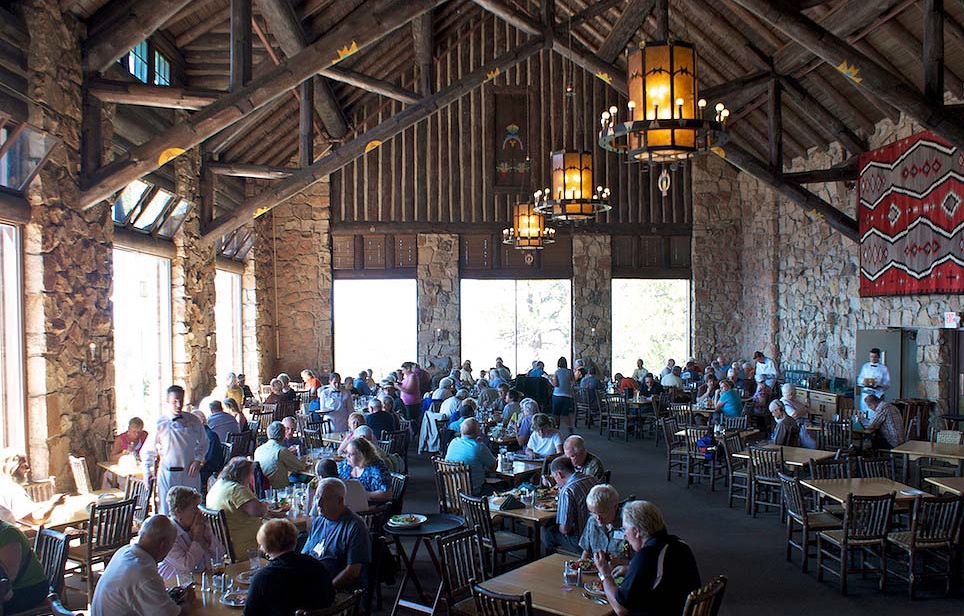
| Route 66 | Cities | Beaches |
|
North Rim |
 |
Granite Rapids |
Escalante |
Marble Canyon |
Boulder Spring |
| The North Rim is 100% opposite the South Rim in every way. It has a single lodge (below left) surrounded by cabins and a campground. It has one dining hall (above right). The views are quite different, as seen at right. Most of the really massive formations ("temples") in the Grand Canyon are north of the river, so from the North Rim you're much closer to them. The North Rim is a thousand feet higher than the South Rim, so with a good pair of binoculars you find yourself looking down on El Tovar, the South Rim Trail and Grand Canyon Village. With that higher elevation comes a different ecology. The Coconino Forest on the South Rim is mostly pine. The Kaibab Forest on the North Rim is primarily aspen. The North Rim is not crowded at all. It is so hard to get to that only dedicated Canyon visitors bother. The result is a very calm, quiet, unhurried atmosphere. It's a lot colder on the North Rim. Even in Summer, nights get chilly. These cabins don't need air conditioning. There's no South Rim Trail here, snaking along the edge for five miles. But there are numerous spectacular overlooks. There are not the six major trails here descending into the Canyon. There's only one, the North Kaibab, the way you came. But there are several trails leading through the forest to various overlooks. | 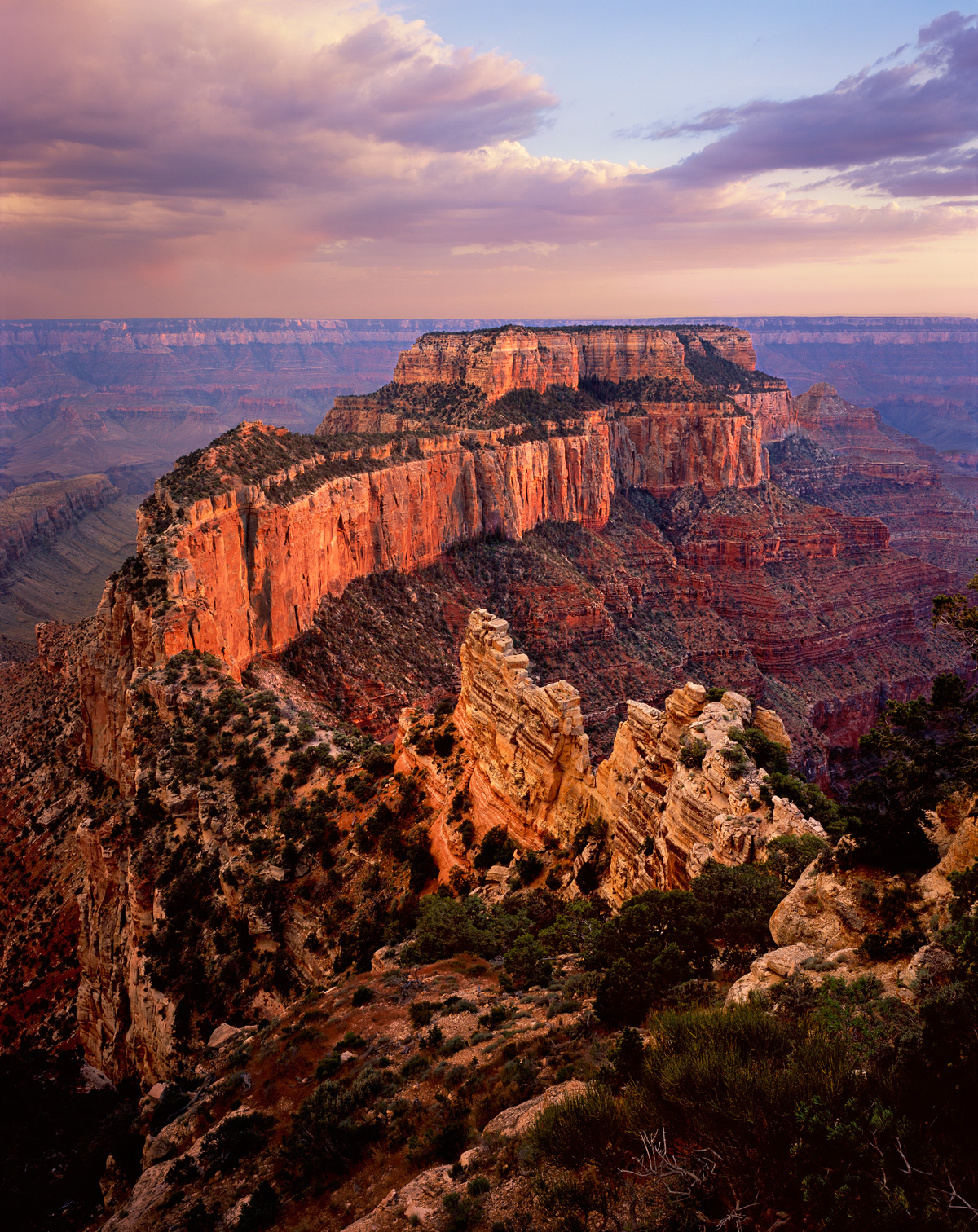 |
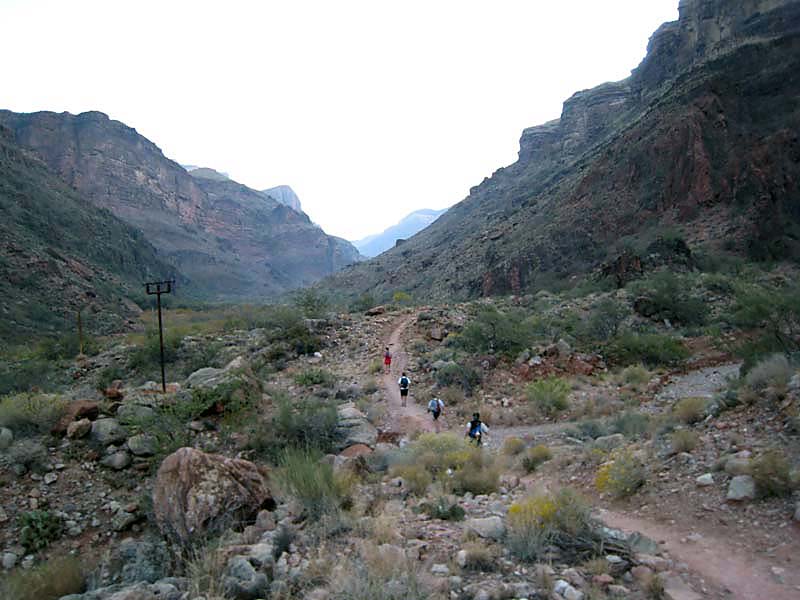 |
The North Rim is the northern end of the Kaibab - Bright Angel Corridor, which includes Indian Garden, Phantom Ranch and Cottonwood. We really advise you to start out with the Indian Garden or Phantom Ranch overnights while you get used to the heat, terrain and other aspects of backpacking in the Grand Canyon. But if you're experienced and in good shape, the Rim to Rim and Back trip is the classic Canyon experience. The most common sequence begins with South Kaibab to Phantom Ranch the first day. For a detailed description of that trail, go to the Hiking section to the South Kaibab page. The second day of that sequence is the hike from the Ranch to Cottonwood with the side trip to Ribbon Falls. For photos of The Box (the "microwave" section of the trail), and the Falls, go to the Phantom Ranch page of this Backpacking section. Here we show three more photos along the North Kaibab Trail en route to Cottonwood. To the left here are four day hikers in Bright Angel Canyon climbing out of The Box. Below are three rest stops between The Box and Cottonwood. That's the water from Roaring Springs gushing down the hillside in the center photo. Also note the white plastic water jug hanging off the pack in the photo at right, and the blue rain cover drying in the sun from the usual afternoon shower. All three hikers are carrying external frame packs, ideal for this hot desert terrain. |
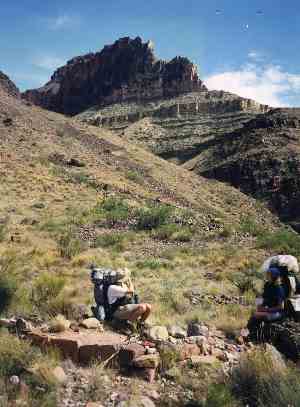 |
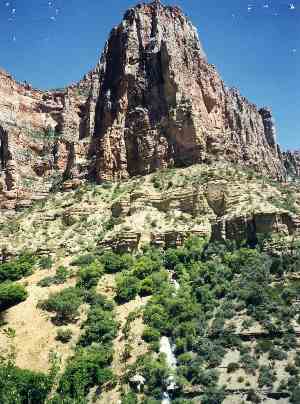 |
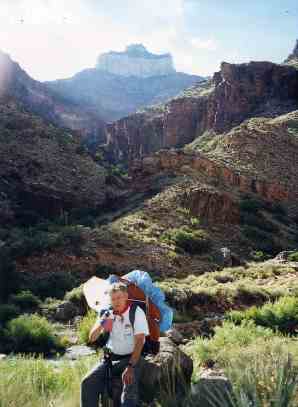 |
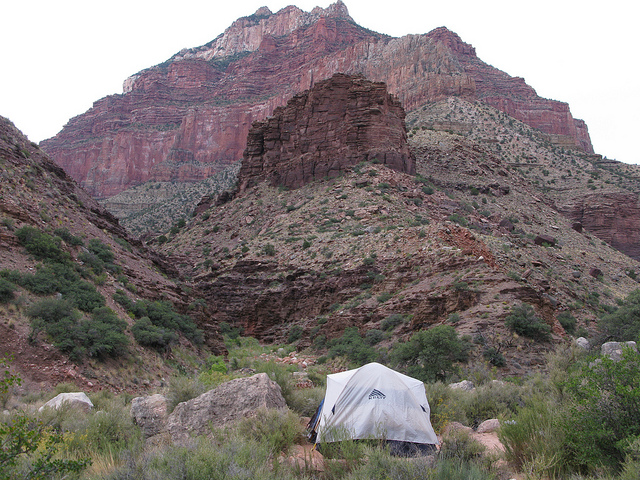 |
Cottonwood Campground is shown at left. Although we pitched this tent here for good views of the sunset and sunrise, most of Cottonwood is in a clump of trees along Bright Angel Creek. There's a ranger station, composting toilets and drinkable water, but no showers. As you can see, Cottonwood is in a spectacular location. You could spend an extra day there just for the photographs. It's also a very popular campground, with all the backpackers making the Rim to Rim trip. You'll want to leave the Ranch early and not stop too often or too long so you can claim a good spot. We like to get on to Cottonwood, set up camp, then hike back down to Ribbon Falls, rather than stop there on the way up with full packs on. If you're into serious climbing you might camp here for a couple of nights and climb a few formations. Some can be summitted by scrambling without ropes, but the highest usually get pretty technical toward the tops. |
The third day is the hike up Roaring Springs Canyon to the Rim. This is a long haul, 6.7 miles and 4600 feet of elevation. By now you've seen lots of spectacular scenery, but many veteran Canyoneers, who have explored from Marble Canyon to Havasu Falls, consider this the best of all. You begin with a two mile hike up from Cottonwood. There's a ranger facility, pumping station and water faucet at Roaring Springs, which is a key source of water for the inner canyon. Bruce Aiken lived here with his wife for 30 years, raising three children and manning the pumps. He spent all of his spare time producing a portfolio of paintings. Today, Aiken's works are prized as the finest portrayals ever made of the inner canyon. Roaring Springs itself is the waterfall gushing out of the Mauv Limestone cliffs. Geologists estimate it takes a thousand years for water from snow and rain to seep down through multiple layers of rocks and emerge at the Springs. Water emerges ice cold and 100% pure. Pipes carry it up to the North Rim, down to Cottonwood and Phantom Ranch, over to Indian Garden, and back up to the South Rim. From here, the trail begins winding up the canyon, hugging the cliffs and switchbacking steeply.
|
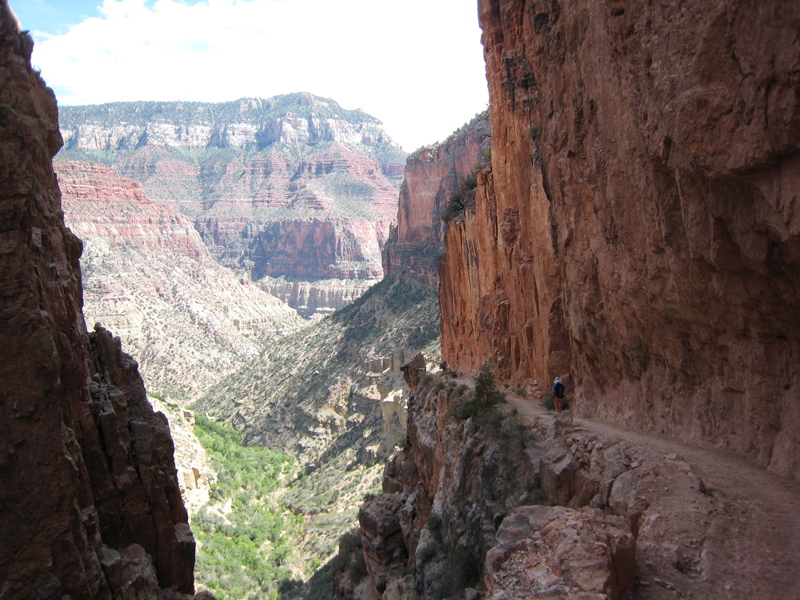 |
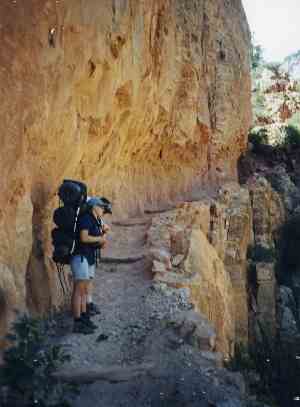 |
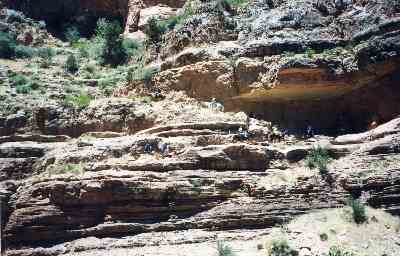 |
| Once you reach the water tanks at the top, do not follow the paved road, which circles the campground. Instead, turn due Southwest and hike through the woods to the road. You can't miss it and this cutoff will save you a 3/4 of a mile walking when your feet are already tired. Turn left on the road and follow it to the lodge. | 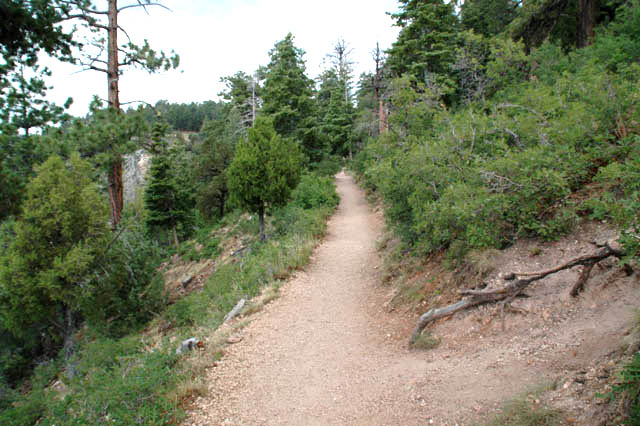 |
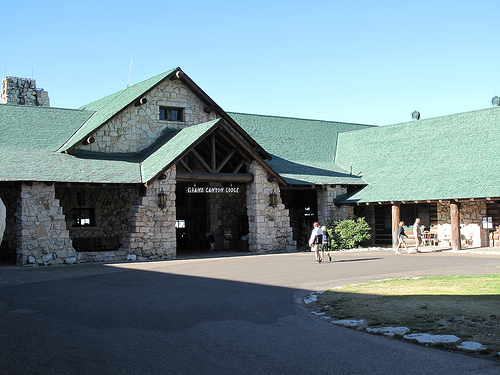 |
We highly suggest at least two nights at the North Rim, which allows you a full day to leisurely explore the area and rest your legs and feet for the return. The photo at left shows the front entrance to the lodge. As you hike in along the road, this is how you'll approach the building. The office for the cabins is here. The campground is run out of the check station at the entrance. Camp sites also require reservations months in advance. You can get ice cream, pizza and soft drinks in the lodge. |
| The North Rim is a very simple place. It includes a lodge, 130 log cabins, a very spacious campground, a stable with corrals, and three hiking trails in addition to the North Kaibab Trail you came in on. Don't count on watching TV, using your cell phone or getting online. You might get to, but reception is always iffy. There'is a former employee dorm retrofitted as motel style lodging for tourists. The lodge itself does not contain guest rooms. The Transept is the favorite hiking trail. It is 1.5 miles long and extends from the lodge to the campground. It is incredibly scenic because it winds through Aspen forest and looks down into Transept Canyon and across to Oza Butte and Manu Temple. Be sure to look for the Kaibab Squirrels. The inner canyon is too hot for them to cross, so in effect they've been isolated here from their South Rim cousins. Over thousands of years, the Kaibab Squirrels evolved in different directions until today the two are different species and cannot mate. You can see the difference. A Kaibab Squirrel just does not look the same as the squirrels you're used to. | 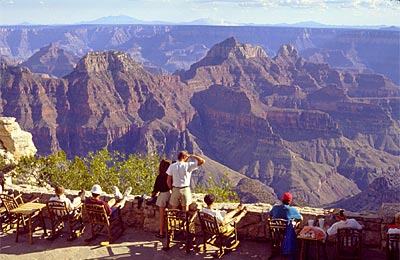 |
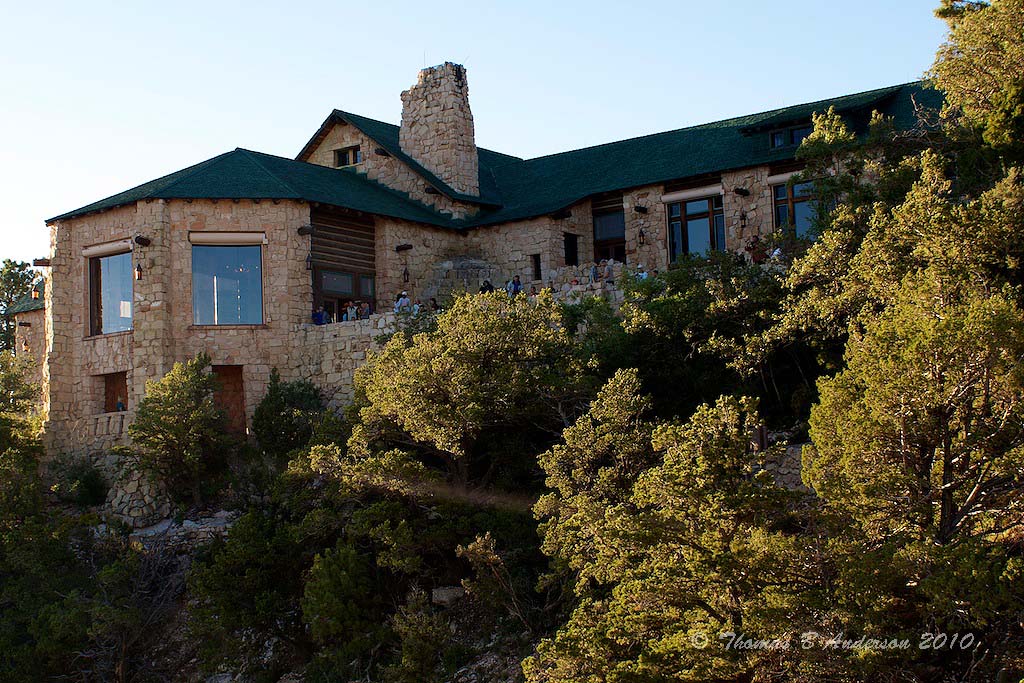 |
The Grand Canyon Lodge and surrounding cabins were built in 1937. They're only open from May 15 to October 15 because the North Rim is buried in snow seven months a year. The lodge is beautifully designed in classic national park architecture. The dining hall is seen in the photo top right. Decks open from the lodge, as seen in the photo above right, and are always crowded for sunrises and sunsets. There's a gift shop quite similar to the ones on the South Rim. The largest Navajo rug in the world hangs inside the lodge and the hallways are decorated with other artifacts. Two lookout points extend out from the lodge onto rock promontories. |
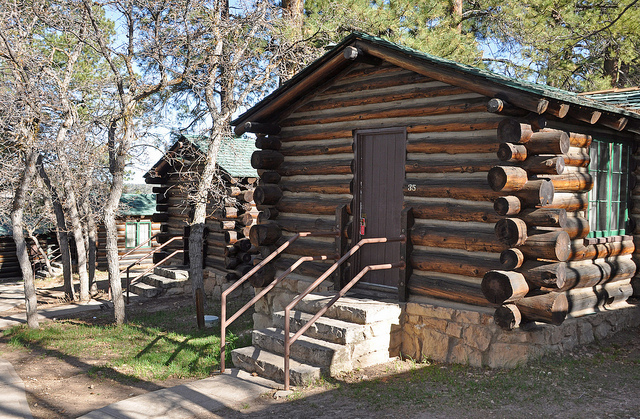 |
The fantasy lodging at the North Rim is to rent one of the Western Cabins. 30 of them sit along the rim, 15 with porches right on the rim. There are one and two bedroom models. Another 100, called Pioneer Cabins, sit back across the road. They rent for less and are easier to reserve. | 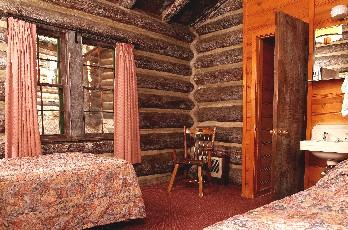 |
| This is Angel Window, one of the more breathtaking overlooks on the North Rim. Notice in the lower right the window. Through it you can see the Colorado River far below. The North Rim doesn't have the single trail winding all along the edge. Instead you have to take individual trails out to the various overlooks. These trails range from half a mile to two miles in length. But they're worth the time and effort. | 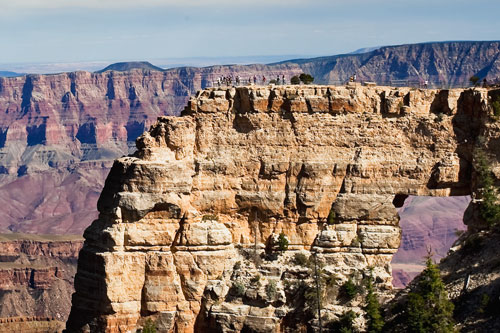 |
 |
On the fifth day you can hike from the North Rim back to the Ranch, and on the sixth day you can hike up the Bright Angel Trail to the South Rim. You could add sidetrips to Clear Creek, Plateau Point or either direction on the Tonto Trail and extend this trip out to 7-10 days. Remember the Grand Canyon Lodge Restaurent and Phantom Ranch can pack you a lunch to take with you on the trail. The photo at left here shows four ultralight hikers coming through Bright Angel Canyon. |
|
|||
|